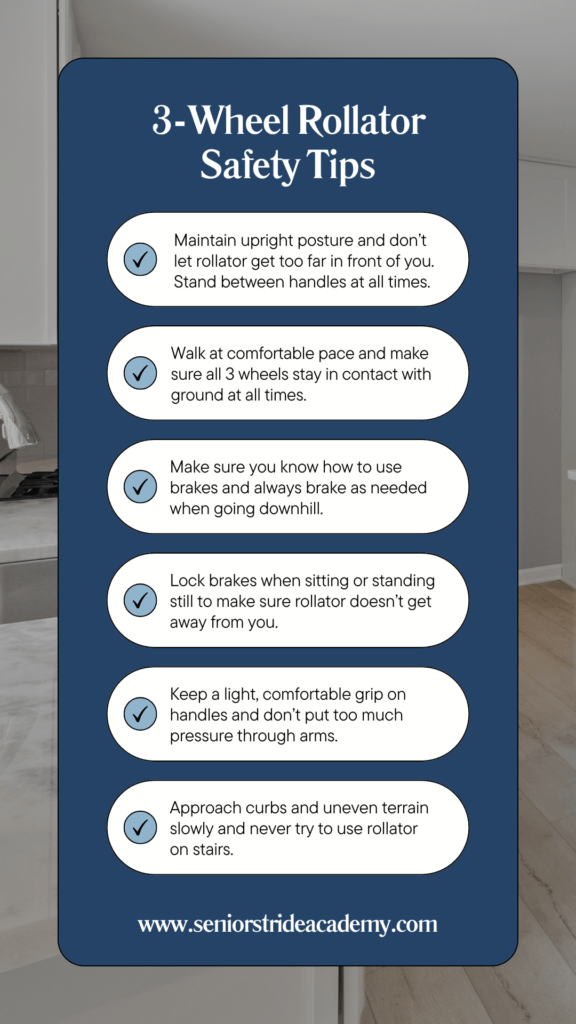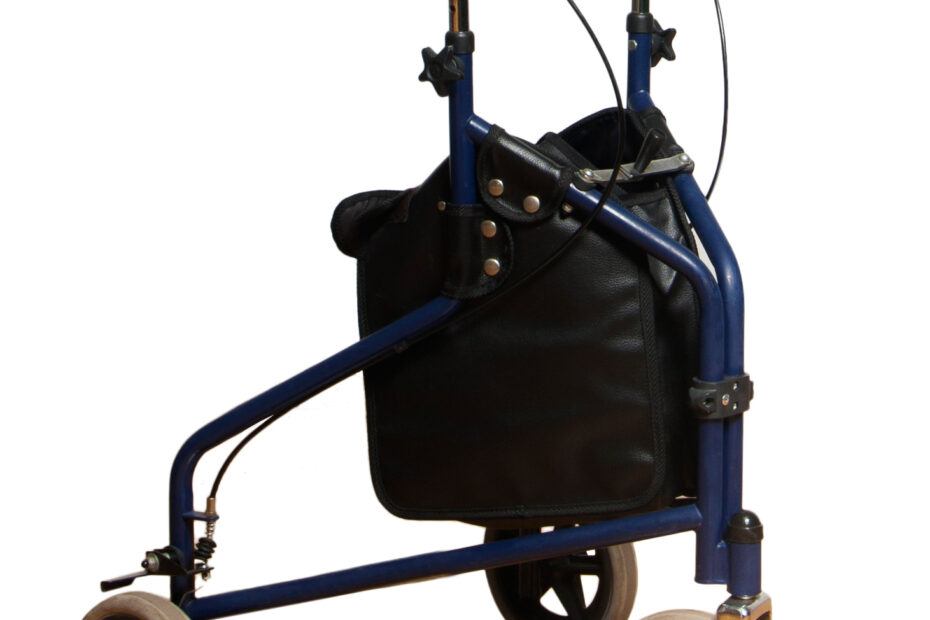Three-wheel rollators are mobility aids designed to support seniors who need help with balance and stability while walking.
But unlike traditional walkers that have four legs for support, these rollators come with three wheels, offering a blend of maneuverability and support.
When comparing 3-wheel rollators to their 4-wheel counterparts, the main difference lies in their design and function.
Three-wheel rollators are typically lighter and more agile, making them easier to steer and fit into narrower spaces.
This makes them a great choice for seniors who might find a larger rollator cumbersome or overwhelming.
That said, losing a wheel has its disadvantages too, like having to give up a little on stability.
Long-story-short: yes, 3-wheel rollators can be safe, but you have to be careful and know how to handle them correctly.
And that’s exactly what we’ll be going over here in this guide.
After reading, you’ll know everything you need to in order to use a 3-wheel rollator safely (or decide these walkers aren’t the right choice in the first place).
Safety Concerns and Drawbacks of 3-Wheel Rollators
While 3-wheel rollators offer a lot of benefits, they do come with their own set of challenges.
These include:
Less Stability
The biggest possible safety concern with a 3-wheel rollator is stability, especially on uneven surfaces.
Because they have fewer points of contact with the ground compared to 4-wheel models, they can be less stable on gravel, grass, or uneven pavement.
This means they are more prone to tipping over if you put too much pressure on them, especially when changing direction.
Carrying Capacity
Another drawback is the smaller carrying capacity.
Most 3-wheel rollators come with limited storage options compared to 4-wheel models.
They usually feature a small pouch or basket for personal items, which might not be sufficient if you need to carry groceries or larger items.
This limitation can be a dealbreaker for some users who rely on their rollator for daily errands.
No Seat
You’ll also notice that most 3-wheel rollators don’t come with a seat, a key feature found on traditional 4-wheel rollators.
If you get tired or short of breath easily while walking, the fact that 3-wheel rollators don’t have this feature could be a dealbreaker.
Before choosing a 3-wheel rollator, it’s crucial to evaluate these concerns and consider how they might affect your daily routine.
Understanding the limitations can help you make a more informed decision and prepare for any potential issues.

Using A 3-Wheel Rollator Safely
Sure, these smaller rollators aren’t perfect, but nothing else is either. And what these walkers give up in stability, they gain in mobility and agility.
These devices take up less room, so they can fit better in smaller homes with less floorspace.
And the triangular, 3-wheel design also makes for a smaller turning radius, making for a more nimble walker.
The key to making the most of these advantages is knowing how to handle these rollators correctly.
Following these guidelines will help you use your rollator safely:
Walking Safely with the Rollator
When using your 3-wheel rollator, proper walking technique is key to maintaining balance and safety.
Always walk close to your rollator, keeping your body centered between the handles. Avoid pushing the rollator too far in front of you, as this can cause you to lean forward and lose balance.
Walk at a comfortable pace too – rushing can lead to accidents, especially on uneven surfaces.
You should always make sure that all three wheels remain in contact with the ground at all times as well.
To make tight turns, slow down and use the rollator’s agility to your advantage. Shift your weight slightly toward the direction of the turn, and guide the rollator smoothly around the corner.
Mastering the Brakes
One of the most important safety features of a 3-wheel rollator is its braking system. Familiarize yourself with how the brakes work before you start using the rollator regularly.
Before each use, squeeze the brake handles to make sure they engage properly and stop the rollator from moving.
Apply the brakes gently as needed, especially when navigating slopes or uneven surfaces. This will help you maintain control.
But avoid holding the brakes and walking at the same time for extended periods, as this could lead to the brakes loosening up and becoming less effective over time.
Always lock the brakes when you’re standing still, sitting down, or preparing to sit. This will prevent the rollator from rolling away and causing a fall.
FYI, you can lock the brakes on rollators by pushing the brake handles down until they ‘click’ in place.
Navigating Different Surfaces
A 3-wheel rollator is versatile, but different surfaces require different techniques.
When using the rollator indoors, be cautious of rugs, mats, and uneven flooring. These can cause the rollator to tip if you’re not careful.
Move slowly and keep an eye out for potential hazards.
When outdoors, larger wheels on the rollator can help navigate uneven terrain like grass, gravel, or cobblestones.
However, always use the brakes when going downhill and avoid overly steep or rocky paths where the rollator might become unstable.
If you need to navigate a curb, approach it head-on, and use the brakes to steady the rollator.
Lower the front wheel onto the lower surface first, followed by the back wheels.
Never attempt to use the rollator on stairs!
Carrying Items Safely
Many 3-wheel rollators come with baskets, bags, or trays for carrying items. However, overloading these storage areas can affect the rollator’s stability.
Place items in the center of the basket or bag to avoid tipping.
Avoid hanging heavy bags on the handles, as this can throw off the balance of the rollator.
Stick to carrying only the essentials to ensure the rollator remains easy to control.
Is a 3-Wheel Rollator Right for You?
While a 3-wheel rollator has many advantages, it’s important to consider your personal mobility needs before making a purchase.
This type of rollator is ideal for individuals who:
- Need a little help with balance, but don’t require a heavy-duty or overly stable walker
- Desire more flexibility and easier maneuvering in tight spaces
- Want a lightweight and portable option for frequent travel or outings
If you require extra stability due to more significant mobility challenges, you might want to consider a 4-wheel rollator or another type of walker.
However, for those who value portability and agility, a 3-wheel rollator could be the perfect solution.
Final Thoughts
Well, there ya have it.
When used properly, a 3-wheel rollator can be a convenient walking companion that improves safety without being too obtrusive.
I’ve worked with many patients over the years that love 3-wheel rollators, but as mentioned above, it really depends on your specific needs.
The space-saving and mobility perks are great, but the 3-wheel design does make these rollators easier to tip over.
So they’re really best suited for seniors who don’t need a ton of assistance while walking.
If you need extra stability or feel less confident on your feet, you may be better off with a 4-wheel rollator or walker.
And again, these smaller rollators rarely come with a seat, so if you get short of breath easily, you may be better off with a larger rollator that has a seat included.
When in doubt, it’s always a good idea to consult with your healthcare provider or physical therapist to get a professional opinion.
These professionals can assess your specific needs and recommend models that would be most effective for you.
They can also provide insights into any adjustments or customizations you might require for optimal comfort and safety.
Anyway, I hope you found this article helpful and if you have an questions or comments, please leave ’em below and I’ll get back to you shortly.



